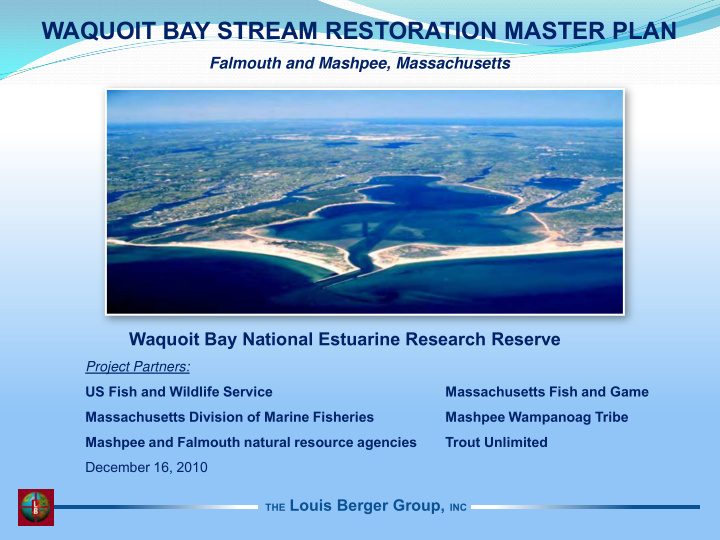



WAQUOIT BAY STREAM RESTORATION MASTER PLAN Falmouth and Mashpee, Massachusetts Waquoit Bay National Estuarine Research Reserve Project Partners: US Fish and Wildlife Service Massachusetts Fish and Game Massachusetts Division of Marine Fisheries Mashpee Wampanoag Tribe Mashpee and Falmouth natural resource agencies Trout Unlimited December 16, 2010 THE Louis Berger Group, INC
Hingham Bay Stream Systems: • Childs River • Bourne Pond • Quashnet River • Red Brook • Dutchman’s Creek • Abigails Brook • Flat Pond THE Louis Berger Group, INC
Restoration Opportunities: • Diadromous Fish Habitat • Cold Water Fish Habitat • Freshwater Wetland • Tidal Wetland • Watershed Approach THE Louis Berger Group, INC
Spring Sapping Valleys (from: Schwarzman 2002 and Finch-Cape Cod) THE Louis Berger Group, INC
Cranberry Production THE Louis Berger Group, INC
Watershed Impacts • Channel straightening • Disconnected floodplains • Loss of woody material/riparian forest Quashnet Bogs • Elevated water temperatures • Impounded conditions • Lack of flow regime diversity • Obstructions/loss of connectivity Cranberry Production THE Louis Berger Group, INC
Components Data Gathering/Site Visits • Historical mapping/photos • Previous studies • On-going research • Personal communications • Field reconnaissance Restoration Master Plan • Data inventory/compilation • Prioritization • Recommendations Public Meeting Conceptual Design of Priority Sites THE Louis Berger Group, INC
Hingham Bay Inventory of Potential Sites Childs River 12 Bourne Pond 2 Quashnet River 16 Red Brook 5 Dutchman’s Creek 2 Abigails Brook 4 Flat Pond 1 THE Louis Berger Group, INC
Restoration Priority Criterion Ecological Feasibility Obstructions/loss of connectivity Local support Restoration area (fish/wildlife) Ownership Existing populations Complexity (construction/regs) Stream flow/hydrology Cost/Funding sources Water quality Multiple environmental benefits Education/Recreation Public access Proximity to schools On-going research THE Louis Berger Group, INC
Lower Childs • River-Carriage Shop Dam • Middle Quashnet River- Abandoned Bogs Upper Quashnet • River-Bog Complex Abigails Brook • THE Louis Berger Group, INC
Current issues: • Existing fishway in poor condition • Falmouth Rod & Gun Club ponds very shallow with extensive aquatic vegetation growth and sediment accumulation • Impoundment acts to increase water temperatures in brook trout stream with most trout occurring below dam Riverways study (Milone & MacBroom 2008) recommended full dam removal at cost of up to $575,000 Other options include: • Replacement of existing fishway with new “technical” fishway (such as Denil, but upstream herring passage not a major objective for river) • Partial dam removal with conversion of existing fishway channel to nature-like fishway, lower pond level, create new stream channel, wetland restoration (preferred) THE Louis Berger Group, INC
• Creates stream habitat in new stream channel in former pond, and in nature-like fishway • Provides for fish passage at the site for river herring, trout, and other species • Allows for restoration of scrub- shrub and forested wetland in former pond • Lower cost than full dam removal THE Louis Berger Group, INC
Nature-like fishway: • Estimated head – 4 feet • Slope – 20:1 to 30:1 depending on topography and head • Length – 80 to 120 feet, drop per pool approx. 6 inches • Width – 15 to 20 feet • Rock/boulder weirs with interspersed instream boulders and cobble/gravel substrate in pools • Design flow – 15 to 20 cfs -based on average monthly flows on the Quashnet River – max. annual flows on Quashnet typically 30 to 40 cfs. (Design flows to be prorating by drainage area) • Current outlet from pond to be replaced and stabilized THE Louis Berger Group, INC
Nature-Like Fishway POOL SECTION B-B’ THE Louis Berger Group, INC
Current issues: • Several water control structures remain from past cranberry operations • Open for fish passage • Potential for structural failures • Impediments to river connectivity and wildlife passage in river corridor Lower Quashnet River bogs abandoned and purchased • Potential for flow by Division of Fisheries and Game – 1956 (picture of David Leonowicz near Martin Rd., 1953) restriction/impounding of flows • Channel location/spring seeps THE Louis Berger Group, INC
1950’s Aerials THE Louis Berger Group, INC
Restoration Opportunities THE Louis Berger Group, INC
Potential Restoration Measures: • Regular inspection & maintenance program to ensure structures are open • Removal of failing concrete structures, leave associated berms in place • Removal of concrete structures and berms, river corridor restoration • Those to remain subject to regular inspections • In-stream habitat enhancement • Restore natural stream process, function and values (self-sustaining) THE Louis Berger Group, INC
THE Louis Berger Group, INC
Impairments: Cutting of white cedars, shingle mill • dam, cranberry cultivation (mid-1900’s) Ethylene Di-bromide (EDB) Treatment • • Channel straightening Quashnet Bogs • Disconnected floodplains • Loss of woody material/riparian forest • Elevated water temperatures • Loss of wetland habitat • Lack of flow regime diversity • Obstructions/loss of connectivity THE Louis Berger Group, INC
Reference Wetlands Red Maple Swamp Atlantic White Cedar Swamp THE Louis Berger Group, INC
Restoration components • Restore natural stream alignment, width, depth, slope, and substrate (sand/gravel with upwelling cool water) • Stream flow regime/diversity • Bank stability • Establish forested wetland/riparian forest/shading • Logs and root wads • Restore wetland hydrology (elevate groundwater-grade controls/plug ditches) • Modify bog surface • Atlantic white cedar/red maple plantings • Planting/Deer exclusion fencing THE Louis Berger Group, INC
THE Louis Berger Group, INC
THE Louis Berger Group, INC
Photos Courtesy of Alex Hackman, MA DER THE Louis Berger Group, INC
Photos Courtesy of Alex Hackman, MA DER THE Louis Berger Group, INC
THE Louis Berger Group, INC
Impairments: • Tidal Restriction • Obstructions/loss of connectivity • Invasive species • Channel straightening • Disconnected floodplains • Fish run potential (Fells Pond) THE Louis Berger Group, INC
WAQUOIT BAY STREAM RESTORATION MASTER PLAN Falmouth and Mashpee, Massachusetts Next Steps: • Finalize Master Plan • Complete Conceptual Design of Priority Projects • Public outreach-build support • Seek funding opportunities to advance design and implementation THE Louis Berger Group, INC
Recommend
More recommend